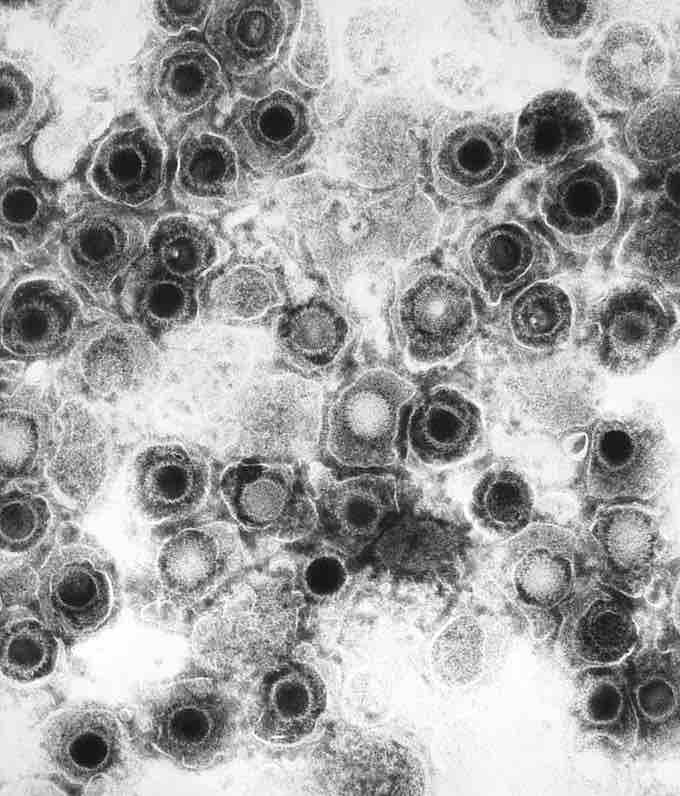Herpesviridae is a large family of DNA viruses that cause diseases in animals, including humans. The members of this family are also known as herpes viruses. The family name is derived from the Greek word herpein ("to creep"), referring to the latent, recurring infections typical of this group of viruses.
Animal herpes viruses all share some common properties. The structure of these viruses consists of a relatively large double-stranded, linear DNA genome encased within an icosahedral protein cage called the capsid, which is wrapped in a lipid bilayer called the envelope . The envelope is joined to the capsid by means of a tegument. This complete particle is known as the virion. HSV-1 and HSV-2 each contain at least 74 genes within their genomes, although speculation over gene crowding allows as many as 84 unique protein-coding genes by 94 putative pen reading frames. These genes encode a variety of proteins involved in forming the capsid, tegument and envelope of the virus, as well as controlling the replication and infectivity of the virus.
Herpesviridae
Various viruses from the Herpesviridae family seen using an electron micrograph Amongst these members is varicella-zoster (Chickenpox), and herpes simplex type 1 and 2 (HSV-1, HSV-2).
Types of herpes viruses
There are nine distinct herpes viruses which cause disease in humans:
- HHV‑1 Herpes simplex virus-1 (HSV-1)
- HHV-2 Herpes simplex virus-2 (HSV-2)
- HHV-3 Varicella zoster virus (VZV)
- HHV-4 Epstein-Barr virus (EBV)
- HHV-5 Cytomegalovirus (CMV)
- HHV-6A/B Roseolovirus, Herpes lymphotropic virus
- HHV-7 Pityriasis Rosea
- HHV-8 Kaposi's sarcoma-associated herpesvirus
Of particular interest include HSV-1 and HSV-2, which cause oral and/or genital herpes, HSV-3 which causes chickenpox and shingles, and HHV-5 which causes mononucleosis-like symptoms, and HHV-8 which causes a Kaposi's sarcoma, a cancer of the lymphatic epithelium.
Infection is caused through close contact with an infected individual. Infection is initiated when a viral particle comes in contact with the target cell specific to the individual herpes virus. Viral glycoproteins bind cell surface receptors molecules on the cell surface, followed by virion internalization and disassembly. Viral DNA then migrates to the cell nucleus where replication of viral DNA and transcription of viral genes occurs.
During symptomatic infection, infected cells transcribe lytic viral genes. In some host cells, a small number of viral genes termed latency-associated transcripts accumulate instead. In this fashion, the virus can persist in the cell (and thus the host) indefinitely. While primary infection is often accompanied by a self-limited period of clinical illness, long-term latency is symptom-free.
Reactivation of latent viruses
This has been implicated in a number of diseases (e.g. Shingles, Pityriasis Rosea). Following activation, transcription of viral genes transitions from latency-associated transcripts to multiple lytic genes; these lead to enhanced replication and virus production. Often, lytic activation leads to cell death. Clinically, lytic activation is often accompanied by emergence of non-specific symptoms such as low grade fever, headache, sore throat, malaise, and rash, as well as clinical signs such as swollen or tender lymph nodes, and immunological findings such as reduced levels of natural killer cells.
There is no method to eradicate the herpes virus from the body, but antiviral medications, such as acyclovir, can reduce the frequency, duration, and severity of outbreaks. Analgesics such as ibuprofen and acetaminophen can reduce pain and fever. Topical anesthetic treatments such as prilocaine, lidocaine, benzocaine or tetracaine can also relieve itching and pain.

Herpes Simplex Virions
This negatively-stained transmission electron micrograph (TEM) revealed the presence of numerous herpes simplex virions, members of the Herpesviridae family. There are two strains of the herpes simplex virus, HSV-1, which is responsible for cold sores, and HSV-2, which is responsible for genital herpes. At the core of its icosahedral proteinaceous capsid, the HSV contains a double-stranded DNA linear genome.